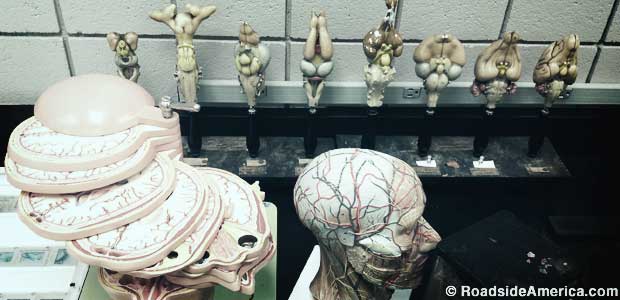
Brain models.
Brain Museum
Buffalo, New York
"This is probably the biggest display of brains you'll ever see," said Dr. Chris Cohan, curator of the Brain Museum and professor of pathology at the University at Buffalo's School of Medicine. He's probably right; the museum exhibits dozens of brains, human brains, row after row, neatly shelved and cheerfully lit. In their fluid-filled brain-containers they appear to float like corrugated jellyfish.
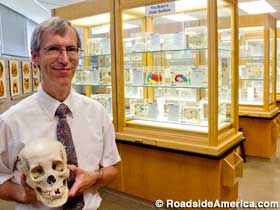
Dr. Chris Cohan at the Brain Museum.
The collection is known officially as the Museum of Neuroanatomy, but nearly everyone, even Dr. Cohan, calls it the Brain Museum.
It was the brainstorm of Dr. Harold Brody, Dr. Cohan's predecessor and mentor. Dr. Brody was inspired to make The Brain Museum after a visit to Denmark, where he saw a museum of brain specimens. He then spent the next 30 years painstakingly teaching himself how to dissect and display human brains, a delicate technique that requires the talents of a... brain surgeon. "He believed that all people are interested in brains," said Dr. Cohen, "and all people should have the opportunity to see them."
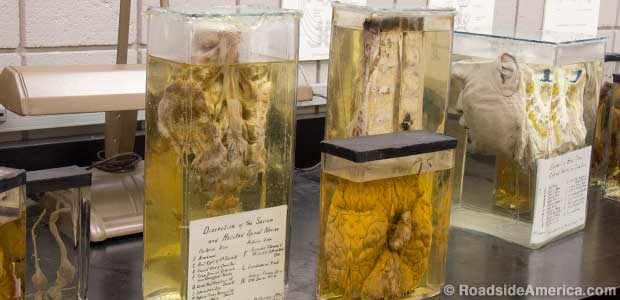
While a place like the Glore Psychiatric Museum dwells on the dysfunctional aspects of the brain, the Brain Museum is a showcase of the Common Brain, offering visual proof that within our skulls we are all equal -- unless we have a tumor, an aneurysm, a split corpus callosum, or Alzheimer's. These problem brains are displayed in the museum, too, some garnished with colorful pins to highlight their defects.
"People always wonder how is that brain different from my brain," said Dr. Cohan. "'Can you tell by looking at me what kind of brain I have?' I get asked that a lot." (The answer is no.)
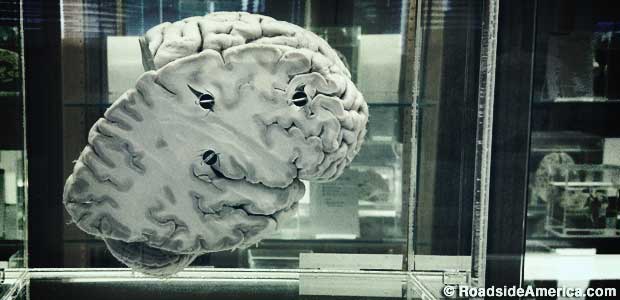
Dr. Cohan showed us interactive exhibits: a human skull; a piece of "brain coral" for comparison; a model of a human head sliced horizontally to reveal different interior structures; and a German-mounted display of rabbit, pigeon, and fish brains-on-sticks that compares brain sizes. On a counter sat a tank with the head of a man with a moustache; the back half of his head and everything above his ear was gone, removed to show the connections between his brain stem and spinal cord. According to its label, it's been in that tank since 1943.
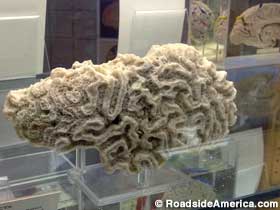
Brain coral.
So where does the Brain Museum get its samples? Dr. Cohan said that most are retrieved from the 200 to 400 bodies donated each year to the medical school. "I'll try to take the one that looks in the best shape," he said, mentioning a vat that holds up to 50 brains at a time, named The Think Tank. We suggested to Dr. Cohan that a replica Think Tank might make a good bobbing-for-apples-style exhibit for the museum. Dr. Cohan replied that it's just that kind of idea that make devising real interactive brain displays difficult (He meant it as a compliment).
Dr. Brody was not a completist collector; he recognized the limits of supply and demand. "Famous brains are hard to come by," said Dr, Cohan, adding that even if brains of celebrities and Presidents were in the collection, its policy of anonymous donations ensures that no one would know it. "And anyone who dies in Buffalo of a rare disease is going to the coroner, not here. You can't just call up and say, 'Oh, I'd like to have that brain; send it to me.' It doesn't work that way."
Still, the museum's collection of brains continues to grow; "85 with more to come," said Dr. Cohan, pursuing its mission to enlighten everyone from tourists to neurosurgery students, confident that the average human brain is interesting enough to draw a crowd, which it has since it opened in 1994.
"People," said Dr. Cohan, "want to see what a real human brain looks like."





